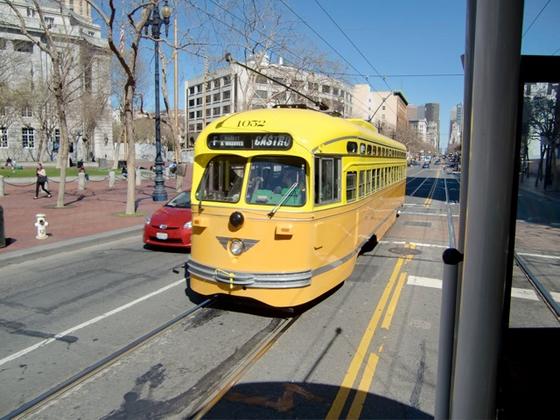When Los Angeles Railway bought its first PCC in 1937, they pulled off a publicity coup by getting then-child star Shirley Temple to unveil it. Today, that first PCC has been fully restored by the Orange Empire Railway Museum in Riverside County, former Ambassador Shirley Temple Black lives in retirement on the Peninsula, and the spirit of that pioneering PCC is reflected in the F-line fleet by No. 1052.
It’s just back on the street after Muni’s shops gave it extensive roof and body work and a completely fresh paint job. Their attention to detail is fantastic. Paint crew leader Carole Gilbert noticed that the silver striping in the back didn’t exactly match photographs of the originals she had obtained since the car was first painted in this livery in the early 1990s. She called us and asked if we would look at some alternatives with her. It’s a bit of a tricky deal, because the original LA Railway PCCs were an early model with no “standee” windows above the main side windows, so the striping couldn’t be precisely the same. But we found the closest approximation, and for good measure, the original “Railroad Roman” car numbers were applied, in the correct color.
These “tribute liveries” that are seen on the F-line can never be exactly right (except on cars that actually ran in the cities they portray) because Muni’s fleet is standardized around three body types instead of the half-dozen or more variations of the PCC that were used in the car’s 16-year production span. There are limits to the number of paint colors that can be stored as well. But once again, the Muni maintenance team has done two cities proud with its work — and we hope Shirley Temple Black has a chance to see it one of these days as well!
Comments: 2
Comments are closed.

It is good that these cars are getting their long-overdue overhaul. These cars have proven to be true workhorses in their third lifespan PTC into SEPTA to MUNI and Morrison Knudsen rebuild program to MUNI.
Actually, this wasn’t a complete overhaul by any means. It was more focused on body work, needed because the rebuilding done by Morrison-Knudsen left much to be desired in getting all the rust out of the cars…besides which, of course, that work was done almost 20 years ago now (as hard as that is for some of us to believe). A true general overhaul of the 1050 class of cars (plus the three original Muni double-enders in the original F-line fleet) is now being scoped. The work Muni has done on cars like 1052 will lessen the need (and cost) for parts of that general overhaul.